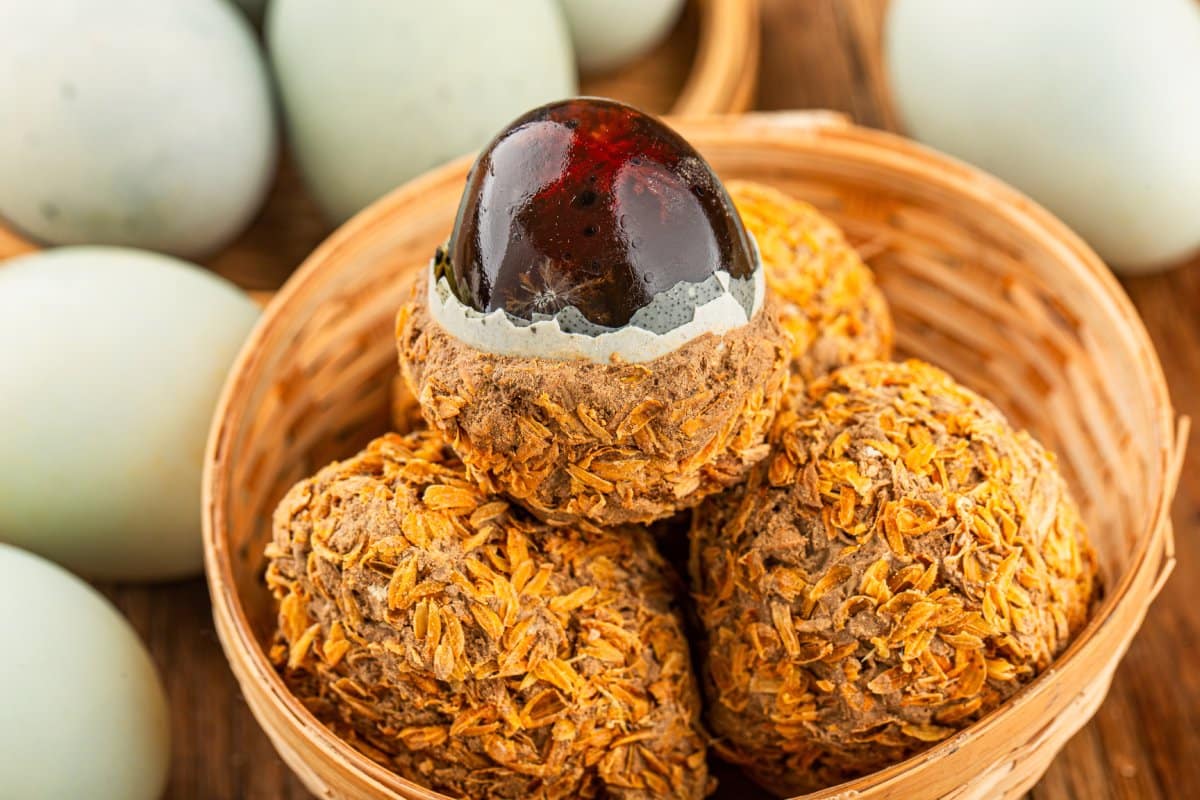Exploring food markets can be an adventure, especially when you encounter ingredients you never knew existed. Are you ready to try what strange and surprising delicacies the world has to offer?
1. Snake Wine (Vietnam)

Found in markets across Vietnam, snake wine is made by infusing whole snakes in rice wine. It’s believed to have medicinal properties and is definitely not for the faint of heart.
2. Century Eggs (China)

Century eggs, also known as hundred-year eggs, are preserved eggs with a creamy yolk that turns dark green or black. These are a staple in many Chinese markets and offer a unique, pungent flavor.
3. Hákarl (Iceland)

At Icelandic markets, you might come across hákarl, which is fermented shark meat. The shark is buried, allowed to ferment, and then hung to dry, resulting in a dish with a strong ammonia smell.
4. Black Chicken (Asia)

Silkie chickens, known for their black flesh and bones, are sold in markets across Asia. These chickens are prized for their unique appearance and supposed health benefits.
5. Stink Beans (Southeast Asia)

Also known as petai, these beans are famous for their strong smell, which resembles natural gas. Despite their odor, they are a popular ingredient in many Southeast Asian dishes.
6. Balut (Philippines)

Balut is a fertilized duck egg with a developing embryo inside, sold in many Filipino markets. This street food is boiled and eaten directly from the shell, often seasoned with salt and vinegar.
7. Sannakji (South Korea)

Live octopus is a common sight in South Korean markets. The tentacles are cut and served immediately, still wriggling on the plate, providing a unique, chewy texture.
8. Mopane Worms (Southern Africa)

Dried mopane worms, which are caterpillars of the Emperor moth, are a protein-rich snack in many African markets. They are often rehydrated and cooked with tomatoes and onions.
9. Edible Insects (Thailand)

Thai markets offer a variety of edible insects like crickets, silkworms, and grasshoppers. These insects are often deep-fried and seasoned, providing a crunchy and nutritious snack.
10. Bird’s Nest Soup (China)

Bird’s nest, made from the saliva of swiftlets, is a prized ingredient in Chinese markets. It’s believed to have health benefits and is often used to make luxurious bird’s nest soup.
11. Durian (Southeast Asia)

Known as the “king of fruits,” durian is famous for its strong odor, which can be off-putting to many. Despite the smell, its creamy flesh is highly sought after in Southeast Asian markets.
12. Smalahove (Norway)

In Norwegian markets, you might find smalahove, a traditional dish made from a sheep’s head. The head is split, salted, and sometimes smoked, before being boiled or steamed.
13. Casu Marzu (Italy)

This Sardinian cheese is intentionally infested with live larvae. The larvae break down the cheese fats, resulting in a soft texture and unique flavor that’s not for the squeamish.
14. Kiviak (Greenland)

Kiviak, found in Greenlandic markets, is made by fermenting small seabirds called auks inside a seal skin. The birds ferment for several months, resulting in a strong, pungent delicacy.
15. Fried Tarantulas (Cambodia)

Cambodian markets offer fried tarantulas, a popular snack. The spiders are seasoned and fried until crispy, offering a unique and crunchy treat.
16. Huitlacoche (Mexico)

Known as corn smut, huitlacoche is a fungus that grows on ears of corn. It’s considered a delicacy in Mexican markets, with a rich, earthy flavor used in tacos and quesadillas.
17. Cow’s Blood (Kenya)

In Kenyan markets, cow’s blood is sold as a drink or ingredient in various dishes. It’s often mixed with milk and consumed by certain communities as a traditional food.
18. Sea Cucumbers (Asia)

Sea cucumbers are marine animals sold in many Asian markets. They are prized for their medicinal properties and are used in soups and stews for their gelatinous texture.
19. Cuy (Peru)

Peruvian markets sell cuy, or guinea pig, which is roasted or fried whole. It’s a traditional dish in the Andes, valued for its tender and flavorful meat.
20. Kopi Luwak (Indonesia)

This coffee is made from beans eaten and excreted by civet cats. The digestion process is believed to enhance the flavor, making it one of the most expensive coffees available.
21. Camel Milk (Middle East)

In Middle Eastern markets, camel milk is a common product. It’s considered to be highly nutritious and is used in various beverages and dishes.
Dare to Explore?

These bizarre ingredients show just how diverse and adventurous the world of food can be. Are you ready to step out of your comfort zone and explore these unusual markets?
The post Bizarre Food Markets: The Most Unusual Ingredients You Can Buy first appeared on Mama Say What?!
Featured Image Credit: Shutterstock / yuda chen.
For transparency, this content was partly developed with AI assistance and carefully curated by an experienced editor to be informative and ensure accuracy.





